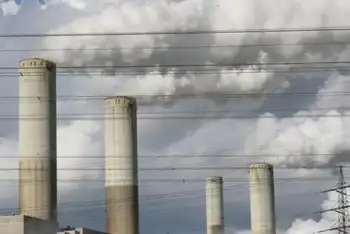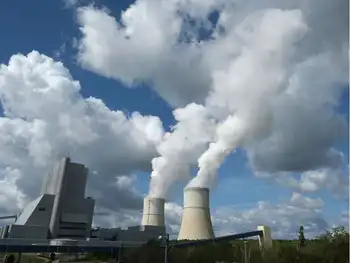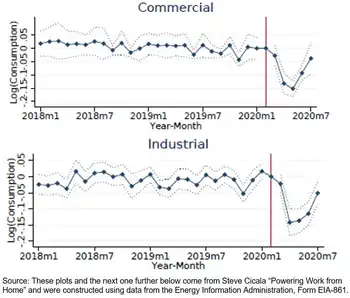Why Blackout Task Force must move quick
By The Toronto Star
Arc Flash Training CSA Z462 - Electrical Safety Essentials
Our customized live online or in‑person group training can be delivered to your staff at your location.

- Live Online
- 6 hours Instructor-led
- Group Training Available
Abraham, the U.S. energy secretary, and Dhaliwal, the Canadian natural resources minister, are mad as hell at the "meltdown," as Dhaliwal calls it, of the supposed fail-safe protections built into the North American electrical transmission grid.
Abraham, who met with Dhaliwal yesterday in Detroit to confer on the international inquiry, has vowed that, "The people who use the system have to adhere to high standards of conduct, or be punished if they fail to do so."
In the aftermath of a plane crash, investigators look for the "black box." Experts in this investigation will be looking at thousands of black boxes, searching for the cause of the blackout in a process that will take several months.
They will pore over every inch of a North American system with more than 6,000 power plants and 378,000 kilometres of wires, operated by more than 3,000 utilities.
They will study thousands of pages of log data, examine data recorders that monitor every power line and relay switch, and listen to voice-recorded conversations in control rooms. They will try to determine what broke, and when.
And perhaps more important, try to learn who said what to whom — or didn't say anything, but should have.
Here's where Abraham and Dhaliwal could speed up the process. Not just to calm our fears about another blackout. But to prevent governments from embracing solutions to non-existent problems.
For instance, the U.S. Congress, at Bush's encouragement, is weeks away from passing an energy bill. Along with measures to upgrade the grid, the bill might approve oil drilling in the environmentally pristine Arctic National Wildlife Refuge, and give billions of dollars in taxpayer subsidies to nuclear power-plant operators and ethanol producers — all in the name of energy security.
But there was no scarcity of power last Thursday, when supply was comfortably ahead of demand. Which prompted experts right from the start to suspect human error.
In a startling comment this week, Michehl Gent, head of the industry-sponsored North American Electric Reliability Council (NERC), said he's convinced that the elaborate rules for managing the flow of current in the system were wilfully broken last Thursday — something that already happens more or less routinely on a small scale.
Either that, Gent said, or the rules are hopelessly out of date. NERC's own 700-page rulebook, complemented by the loophole-ridden rulebooks of every state and utility, was written for the pre-deregulation era.
The rules pre-date the current era of deregulation and soaring power demand, when power plant operators often try to feed too much juice into the grid. That's one of the most dangerous of breaches of proper operating procedures.
Gent famously said the crisis was essentially a "nine-second event." He seemed to suggest only a fraternity of control-room Einsteins gifted with nanosecond judgment could have averted the blackout.
But we learn this week, that's not quite how it happened.
It was more like a four-hour event. Maybe longer.
Irregularities in the Midwest grid were detected as early as the day before the blackout.
And at about noon the following day, more than four hours before eight U.S. states and Ontario were unplugged, abnormal voltage fluctuations were seen on the Midwest grid.
At about 2 p.m. August 14, one of the biggest power plants operated by FirstEnergy Corp. of Akron, Ohio, abruptly shut down. FirstEnergy didn't tell the world about this for two whole days — for "competitive" reasons.
At about 3 p.m. August 14, three of FirstEnergy's high-voltage power lines near Cleveland failed in the space of 35 minutes. That would ultimately trigger sequential failures of more power lines and of power plants further east.
It's been widely reported an alarm system at a FirstEnergy control centre was inexplicably shut off during part of this time, itself a significant violation.
It was revealed this week, however, that FirstEnergy knew soon enough about its failed lines. It had at least three conversations about this with its regional grid operator, the Midwest Independent Transmission System Operator Inc. (Midwest ISO).
So here's the scenario: One of the biggest power plants in the Midwest had gone offline. And several high-voltage power lines had failed, almost certainly diverting huge amounts of juice hither and yon, causing all manner of havoc.
But this week the Midwest ISO could not say whether it had shared this news with other ISOs to the East and South.
A Midwest ISO spokeswoman said her colleagues couldn't be sure if "the lines tripping (failing) were a symptom or a cause" of the looming disaster.
The context is that the Midwest ISO is an industry-sponsored entity, not a government agency. Only three years old, the Midwest ISO is one of the youngest of the self-regulating ISOs set up by the industry after deregulation.
For years, the Midwest region has been cited as a weak link in the national grid. The industry's own quality-control experts said the Midwest was under severe strain, and reliability problems were frequent.
More context: Some utilities are tempted not to err on the safe side — to shut down power plants and disconnect from the grid when there's a hint of trouble.
Rebooting a power plant takes a long time (maybe two weeks, in the case of Ontario's Pickering nuclear reactors).
Power then has to be restored to the utility's service region slowly, neighbourhood by neighbourhood, or the system will crash.
And every incident of failed equipment or improper procedures is supposed to be reported to regulators. The consequences can be harsh. They include regulatory fines, denial of requested rate hikes, and even threats of losing a licence to operate.
As it happens, FirstEnergy had just been denied an anticipated rate hike in New Jersey after one of its utilities there caused a blackout over the July 4 holiday weekend.
FirstEnergy was facing another rate-hike hearing in Ohio as it contemplated what to do and say about its failed power lines and power plant on August 14.
These are the dots that Abraham and Dhaliwal could connect in about nine minutes, during an intense sit-down with FirstEnergy CEO Peter Burg and his counterpart at the Midwest ISO.
Officials in Michigan and Ontario say they would have appreciated a heads-up from the Midwest ISO. The grid operator for Pennsylvania, New Jersey and Maryland, which also reports having received no calls from the Midwest, went ahead and disconnected from the Northeast grid, protecting its own region and stopping the cascade from spreading to the U.S. South.
In the Midwest, "they were struggling with an 800-pound gorilla for an hour, and when it hit here it lasted nine seconds," Stephen Allen of the Northeast Power Coordinating Council told the New York Times.
"The big question is, Could our operators have known about it earlier? Were there calls that could have been made?"
Well, obviously the answer is yes.
If not for Burg's yeoman service in co-hosting an Akron fundraiser for the Bush 2004 re-election campaign last June, we could expect an interim report from Abraham and Dhaliwal quite soon.
If they had the courage, it's possible they could unravel the year's biggest mystery really soon.











